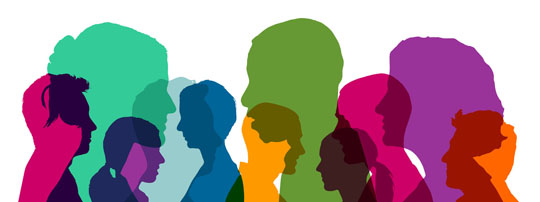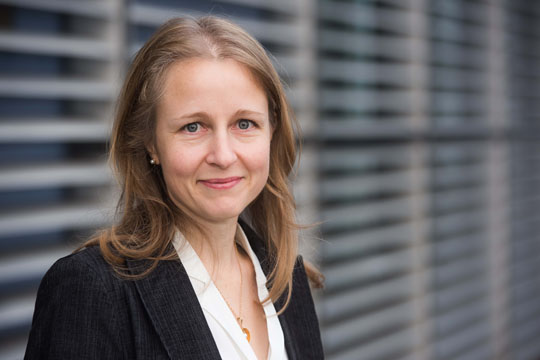The more colorful, the better
Freiburg, Aug 24, 2018
If she asks a colleague at a scientific conference about his work, more than likely she gets a general introduction into the subject matter rather than an answer to her actual question. Based on her experience, the biomaterials researcher Dr. Maria Asplund knows all too well about the unequal treatment of men and women in the entire scientific community and its limiting effect on researchers’ potential. It is diversity that makes the team stronger. In a recently published article, Asplund demonstrates new ways of thinking.
 Photo: Robert Kneschke/Fotolia
Photo: Robert Kneschke/Fotolia
No, human beings are not always as rational as they appear to be. If one were to ask five-year-old children, for instance, to draw a scientist, half of them would draw a female researcher while the other half would draw a male researcher. But after another five years, the likelihood of associating a woman with the word “scientist” decreases significantly: just about one quarter of ten-year-olds, mainly girls, would draw a female scientist. In the teen years, that number drops even more, according to a recent study conducted by a team at Northwestern University in the US.
Dr. Maria Asplund is someone who wants to raise awareness about this disparity. On the side, one could say. As her main job, the Freiburg-based electrical engineer and biomaterials researcher at the Freiburg Department of Microsystems Engineering and her research group at the BrainLinks-BrainTools Cluster of Excellence are currently developing a special polymer that will later be used in medicine and accelerate wound healing. For this Asplund has received a coveted award: the ERC Starting Grant from the European Research Council.
An old issue not yet resolved
Asplund recently spent a lot of time with her colleague Cristin Welle, Assistant Professor of Neurosurgery and Bioengineering at the University of Colorado in the US on an article unrelated to her research, but about the unequal treatment of women and men in the so-called STEM disciplines of science. STEM stands for: Science, Technology, Engineering and Mathematics. “We all carry biases,” she says. “Bias” is what happens daily in the minds of all people. And completely unconsciously.
Asplund states: “We have internalized what something has to be like, for example, that a researcher is male. These implicit assumptions are so profound that they may even corrupt seemingly neutral scoring systems within science, such as grades or credit systems.” As Asplund points out with reference to an investigation by Yale University in the US published in the prestigious journal Proceedings of the National Academy of Sciences, if a candidate is named “John,” the probability that he will get the job and not “Jennifer” is much higher. Even if, from an objective standpoint, Jennifer is as equally qualified as John. The issue is long-standing, but far from resolved, as the recent study results summarized by Asplund and Welle prove.
The latest study results at a glance
The researcher has experienced time again and again that a woman in science is not the same as a man: If she asks a colleague a question about his work at a conference, she often gets a general introduction about it, but no answer to her actual question, as if she did not know what it was about. The topic has preoccupied Asplund for some time. She has often read a lot about it.
 In her home country of Sweden, people have demonstrated significant advancements on the subject. “The unequal treatment in science is much more often discussed and thought about,” says Maria Asplund.
In her home country of Sweden, people have demonstrated significant advancements on the subject. “The unequal treatment in science is much more often discussed and thought about,” says Maria Asplund.
Photo: Klaus Polkowski
In her home country of Sweden, people have demonstrated significant advancements on the subject. “The unequal treatment in science is much more often discussed and thought about.” After a lecture on equality work in science by the chemistry professor Paul Walton in Freiburg, she decided to become active and together with Welle to bring together the latest study results, to develop problem-solving strategies and to bring public awareness to the issue. The scientific article was published in August 2018 in the journal Neuron.
Diverse teams are stronger
The unequal treatment of men and women runs through the entire scientific community, says Asplund: The intricate thing is that everyone participates in it, certainly not on purpose, but regularly nonetheless. Bias can therefore not be reduced to the traditional cliché of the oppressed woman because both sexes distort their reality through their years-long conditioning. Individual prejudices become collectivized - even in science because humans like to remain among their equals. The consequence of this collective bias is that research in laboratories and work groups is limited, thereby sacrificing a lot of know-how, says Asplund. A diverse research team can accomplish a lot more than a homogenous one.
People cannot be reprogrammed through a gender equality officer alone, of this the 39-year-old scientist is certain. It requires a lot more than that. Asplund and Welle have made five recommendations for scientists. It is important to first acknowledge how bias works, and then allow diversity in the next step, for example, in the compilation of scientific teams. Everyone must feel responsible. That includes individuals as well as groups or university committees and institutions. In order to improve science, everyone must be willing to think in new ways. It is a matter of great urgency.
Stephanie Streif
Maria Asplund’s article in the journal Neuron

